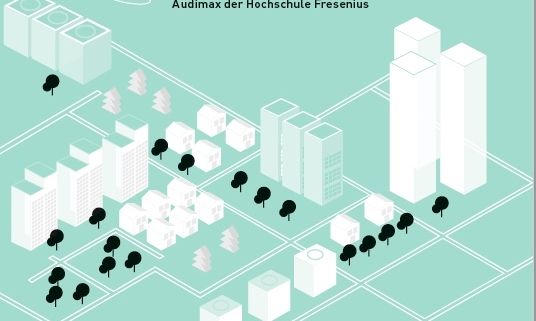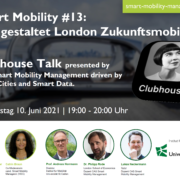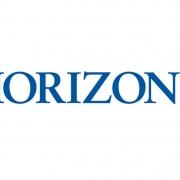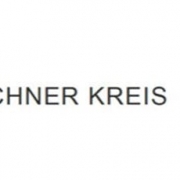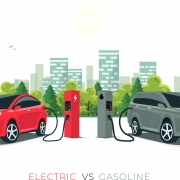Zukunftsforum 2018: Designing Digital Cities
Nach dem Thema Cyber-Security präsentierte und diskutierte die Hochschule Fresenius München am 16. Mai 2018 erstmals gemeinsam mit der Akademie für Mode und Design AMD beim Zukunftsforum 2018 das Thema ‚„Designing Digital Cities“ die Fragen:
- Wie leben und bewegen wir uns in der Zukunft?
- Welche Technologien werden wichtig und was bedeutet dies für Menschen?
- Wie beeinflusst die #NewMobility unsere Lebensqualität?
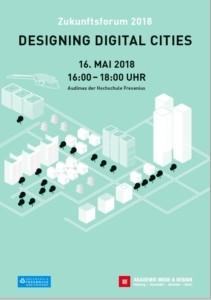
München kann Zukunft, aber andere Städte sind derzeit schneller
Im voll besetzten Audimax begrüßte der Kurator und Moderator Dr. Hans-Peter Kleebinder das Publikum und drei globale Experten aus den Metropolen London, Shanghai und Kopenhagen mit starkem persönlichen Bezug zu München mit folgender Frage:
Was muss passieren, dass München als Epizentrum der Mobilitätsindustrie wieder einen ähnlichen Modernisierungs-Schub wie zuletzt 1972 zur Olympiade erlebt?
Was sind dafür Prämissen und Lösungsansätze?
Denn München hat schon einmal überzeugend gezeigt, wie man Zukunft bewältigen kann: In den nur sechs Jahren von 1966 bis 1972 machte sich die Stadt für ihre Olympischen Spiele von 1972 fit und katapultierte sich mit der dazu entstandenen Infrastruktur um eine ganze Generationsspanne nach vorn.
Der Autoverkehr prägt unsere Städte
Unsere Städte sind heutzutage um das Automobil herum gebaute Infrastruktur. Basis dafür ist die Charta von Athen von 1920 mit ihrem Postulat der Trennung von Wohnen, Produzieren und Einkaufen als Grundlage der globalen Urbanisierung: Die Folge waren unter anderem stets wachsende Pendlerströme zwischen den Stadtteilen und ins Umland hinaus – immer öfter im Automobil. Diese Autoflut hat die Städte durch Stadtautobahnen und Schnellstraßen vereinnahmt. Fast alle sonst verfügbaren Flächen wurden für den parkenden Verkehr zweckentfremdet. In deutschen Großstädten beansprucht der Verkehr und die Parkfläche rund 40 Prozent der gesamten Stadtfläche, in Los Angeles 80 Prozent. Trotzdem sind die Menschen im Auto keineswegs immer mobil. In der chinesischen Hauptstadt Beijing verbringen die Menschen jeden Tag 75 Minuten, also weit über eine Stunde, im Stau; das ist rund ein Arbeitstag jede Woche. In Los Angeles stehen die Autofahrer jedes Jahr mehr als 100 Stunden im Stau, in New York über 90, in München mehr als 50, in Hamburg, Berlin und Stuttgart 44, in Köln und im Ruhrgebiet 40 – also selbst dort noch mehr als eine Arbeitswoche pro Jahr.
Urbanisierung als Treiber für Verkehrsinfarkt und Luftverschmutzung
Zeitgemäße und nachhaltige Lebensqualität sieht anders aus. Einstmals sollte die Funktionstrennung in den Städten unter anderem der besseren Luftqualität in den Wohnvierteln dienen. Heute verpestet der Straßenverkehr die Luft überall in den Städten massiv. Nur ein Beispiel: In Paris ist die Luftqualität für die Bevölkerung das Thema mit der höchsten Priorität;
47 Prozent der Befragten nennen es an erster Stelle noch vor den Themen Wohnungen (46 Prozent) und Bildung (37 Prozent). Wer unsere Lebensqualität verbessern will, der muss von der nicht mehr zeitgemäßen autozentrierten Mobilität zur um den Menschen zentrierten („human-centered“) #NEWMobility kommen.
Diese neue Mobilität reduziert nicht freiwillige Mobilität und setzt multimodale Verkehrsangebote voraus, also Wahlmöglichkeiten zwischen ausreichend kurzen Fußwegen, ausreichend sicheren Radwegen, ausreichend oft verkehrenden Bussen und Bahnen, sowie einfachen Umsteigmöglichkeiten.
Autobenutzung erfolgt dann intelligent verkettet und organsiert per
- Sammeltaxi (in Dubai sind elektronisch miteinander verkettete Pods des Start-Ups NEXT unterwegs),
- Car Sharing (2017 nutzten es in Deutschland 1,7 Mio. Menschen) und
- Ride Sharing (BlaBlaCar als EU Marktführer mit 55 Mio. Rides in 2017).
Eine Grundvoraussetzung dieser multi- und intermodalen #NEWMobility ist deren Verfügbarkeit, eine weitere ist ihre Vernetzung. In London erledigt das die App Citymapper und schafft Transparenz über die verfügbaren Verkehrsmittel für den jeweils situativ und persönlich präferierten Mobilitätsweg. Ein Lösungsansatz ist eine App auf Ihrem Smartphone oder ihrer Smartwatch als persönlicher Assistent für die Organisation des individuellen Mobilitätsbedarfs – das Reisebüro für jeden Weg von A nach B in der Jackentasche, das individualisiert und vorausschauend und dazu lernend für uns reserviert, bucht und abrechnet. 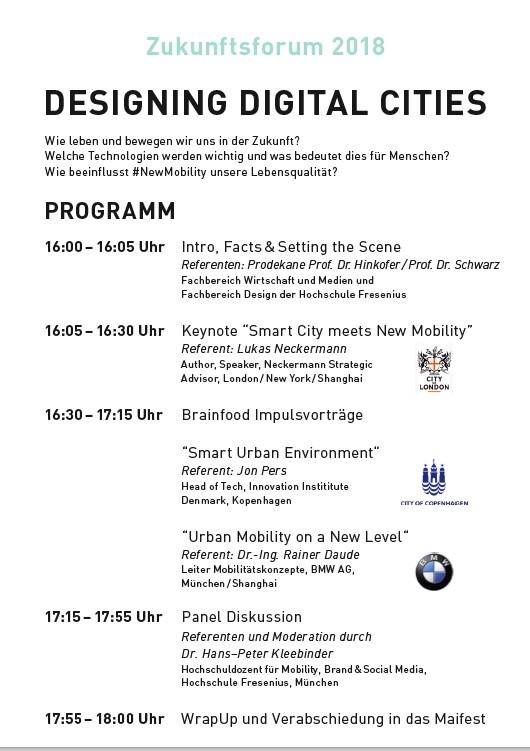
Diese möglichen Prämissen und konkreten Lösungsansätze einer der klimaneutralen, intermodalen und vernetzten #NEWMobility umriss das „Zukunftsforum 2018: Designing Digital Cities“ der Hochschule Fresenius am 16. Mai 2018 in München.
Lösungsansätze aus Kopenhagen, Shanghai und London
Jon Pers, Head of Innovation am Dänischen Innovationszentrum München führte am Beispiel Kopenhagen auf: Die Stadt muss sich entscheiden, wofür sie Geld ausgibt: ob für Fußgänger, Radfahrer oder das Auto.
In der dänischen Hauptstadt hat die Kommunalpolitik den Themen Nachhaltigkeit, Liveability und Technology Vorrang gegeben und dazu dem Radverkehr Priorität 1 eingeräumt. Das Ergebnis: 45 Prozent der Pendler kommen mit dem Fahrrad zur Arbeit oder in die Schule.
Dr. Rainer Daude, verantwortlich für neue Mobilitätskonzepte bei der BMW Group, zeigte mit „Vision E³ Way“ einen innovativen Lösungsansatz für Megacities. E³ steht für „elevated, electric, efficient“ – die charakterisierenden Eigenschaften der Idee, die in und für Shanghai entwickelt wurde: eine modulare, weitgehend überdachte und damit komfortable und sichere Hochstraße über den existierenden Stadtautobahnen als Modell für elektrifizierte Pedelecs, Roller und Motorräder. Deren Tempo wird auf 25 km/h begrenzt und elektronisch kontrolliert – bei freier Fahrt auf kreuzungsfreien Trassen.
Wird es künftig nach diesem Modell Robot-Routen geben, Fahrspuren für selbstfahrende Autos, neben Auto-, Fußgänger-, Fahrrad- und Bus-Spuren?
München, so zeigte das Zukunftsforum, ist mit seinen mobilitätsorientierten Hard- und Software-Firmen für die #NEWMobility eigentlich als Modellstadt und globaler #NEWMobility Hub prädestiniert:
- Tradierte Mobilitäts-Unternehmen wie BMW und MAN und im Umkreis von nur 245 Kilometern Mercedes, Porsche und Audi, neue Mobilitätsangebote wie FLIXBUS/Flixmobility, Clunno aber auch neue Mobilitätsanbieter Lilium Aviation, Volocopter, das TU Projekt Hyperloop und
- neue Player am Markt wie Tesla, Sono Motors, Byton und Faraday und das EU Mobility Cluster der TUM.
Bisher laufen jedoch andere Städte und Metropolen wie Singapur, Dubai, Paris und London der bayerischen Metropole diesen Rang ab.
Den in den USA aufgewachsenen, in London und München arbeitenden Autor und Berater für #NEWMobility, Lukas Neckermann, überraschte das nicht. Je stärker traditionelle Mobilitätsanbieter, vor allem Automobilhersteller, an einem Standort verwurzelt sind, desto mehr zähle die Frage, wie sich deren Arbeitsplätze auch in der #NEWMobility erhalten lassen. Neckermann rechnete vor: Privatautos, die meist nur morgens und abends auf dem Weg zur und von der Arbeit benutzt werden, stehen zu 95 Prozent des Tages unbenutzt herum. Im Car-Sharing werden Autos sechsmal häufiger als ein Privat-Pkw mehrfach am Tag intelligent eingesetzt. Würde jedermann Car-Sharing Angebote nutzen und würden flexible Arbeitszeiten das auch erlauben, könnte der Bedarf an neuen privaten Automobilen auf bis zu ein Sechstel reduziert werden – für die vom Auto geplagten Städte ein Segen, für die Autohersteller aber ein existentielles Problem. Auch dann, wenn sie die Klimawende mit Elektroautos als notwendige (Übergangs)Lösung bewältigen könn(t)en.
Digitalisierung und #NEWMobility wird das Bild unserer Städte verwandeln
Die #NEWMobility hat also, wie die von Dr. Hans-Peter Kleebinder moderierte Diskussion auf dem Zukunftsforum zeigte, nicht nur Freunde, sondern auch natürliche Gegner. Trotzdem muss und wird sie kommen und Antworten auf die Fragen geben:
- Sieht unsere Stadt künftig noch aus wie eine Stadt?
- Sieht unser Auto künftig noch aus wie ein Auto?
Die digitale Revolution bietet hier neue Ansätze und Lösungs- und Gestaltungsmöglichkeiten für eine Verbesserung unserer Lebensqualität für eine lebenswertere und nachhaltigere Zukunft für uns und unsere zukünftigen Generationen.
